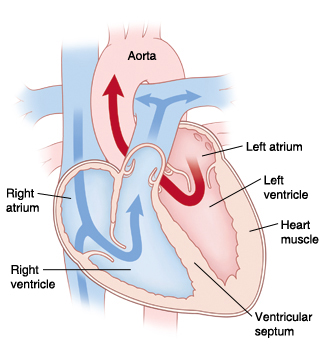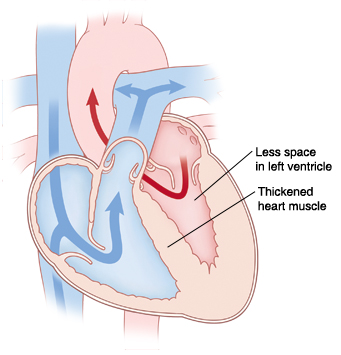When Your Child Has Hypertrophic Cardiomyopathy
When Your Child Has Hypertrophic Cardiomyopathy
Hypertrophic cardiomyopathy is a problem with the heart muscle. It may not cause symptoms that bother your child. But it can lead to serious problems over time. The good news is that it can usually be managed. Your child’s doctor will discuss treatment options with you. This sheet tells you more about this problem and how it is treated.
| |
|
The normal heart
The heart is divided into 4 chambers that hold blood as it moves through the heart. The 2 upper chambers are called atria. The 2 lower chambers are called ventricles. The heart also contains 4 valves between the chambers. The valves open and close to keep blood flowing forward through the heart.
What is hypertrophic cardiomyopathy?
With this condition, the heart muscle thickens. Heart muscle that is too thick can’t pump blood normally. It may affect the entire left ventricle. Or, it may just affect the wall that separates the ventricles (ventricular septum).
Why is hypertrophic cardiomyopathy a problem?
A thickened heart muscle can:
-
Impair blood flow leaving the heart. The thickened wall can block the outflow of blood from the heart to the body or force the valves to close too soon due to changes in pressure. This forces the heart to work harder than normal to pump blood. If the heart no longer pumps blood well, a condition called congestive heart failure (CHF) can develop. In CHF, the inability of the heart to push blood forward appropriately can cause a backup of blood that will eventually stress the lungs and further weaken the heart muscle.
-
Damage heart valves. The mitral valve is most likely to be affected. This valve is found between the left atrium and the left ventricle. Blood may leak backward through the valve. This is called valve insufficiency. Excess blood leakage through the valve puts undue strain on the ventricle so it has to pump extra hard to get all the blood out.
-
Damage electrical cells in the heart. The thickened heart can change the way electricity is conducted through the heart and can affect the cells that control the beating of the heart. Damage to these cells can cause abnormal heart rhythms (arrhythmias). In rare cases, a severe arrhythmia can lead to sudden death.
What causes hypertrophic cardiomyopathy?
This condition can occur in your child by chance. A causemay not always identified. However, hypertrophic cardiomyopathy is one of the most common inherited cardiomyopathies and may be passed from a parent to child in some families. If you or your child has this condition, each close family member should be tested for it. It is important to let your healthcare provider know if there is a history of sudden cardiac death in the family, or death at a young age.
What are the symptoms of hypertrophic cardiomyopathy?
Most children with this condition have no symptoms. If they do occur, they often show up when children are active. Symptoms may include:
-
Lightheadedness, dizzy spells, or fainting
-
Rapid, pounding heartbeat
-
Shortness of breath or tiredness
-
Tightness or pressure in the chest
How is hypertrophic cardiomyopathy diagnosed?
Hypertrophic cardiomyopathy symptoms may be non-specific. Heart problems in children are managed by a pediatric cardiologist. The pediatric cardiologist will do a physical exam to check for any suspicion of a heart problem. Several tests may be done which may help confirm a diagnosis or tell us more about the heart problem. These tests may include:
-
Echocardiogram (echo). Sound waves (ultrasound) are used to create a picture of the heart. This helps find problems with heart structure or function.
-
Electrocardiogram (ECG or EKG). This test records the electrical activity of the heart. It helps find arrhythmias or some problems with heart size or structure.
-
Holter or event monitor. This test records the electrical activity of the heart over time. A special monitor is used. It can help detect problems with the heart rhythm.
-
Exercise stress test. This records the electrical activity of the heart while your child exercises. It helps detect problems with the heart rhythm when the heart beats faster.
How is hypertrophic cardiomyopathy treated?
Treatment is aimed to reduce symptoms and help prevent CHF. It can also reduce the risk of severe arrhythmia and sudden death. Your child’s treatment plan may include:
-
Medicines. Beta-blockers and calcium channel blockers may be prescribed. These medicines can lower blood pressure and slow heart rate. They help to prevent arrhythmias. They may also improve the heart’s pumping action.
-
Surgery. This is done in severe cases. Surgery removes a portion of the heart muscle that is abnormally thickened. Surgery is typically performed when there is obstruction of blood flow out of the heart because of the thickened muscle This improves blood flow from the heart to the body.
-
Implantable cardioverter defibrillator (ICD). An ICD is a device that is placed in the chest. It tracks the heart rate. When needed, it delivers an electric shock to the heart. This stops a life-threatening heart rhythm.
-
Heart transplant. In rare cases, a heart transplant may be needed. Your child’s cardiologist will discuss this with you.
What are the long-term concerns?
-
With treatment, most children with this condition can be active. But they may have to limit certain sports or physical activities. Talk to the doctor about activities that are safe for your child.
-
Your child needs to have regular visits with the cardiologist for the rest of his or her life. This is to check that the heart is working properly. If an ICD is placed, this needs regular checks.
-
Your child may need to take medicine for the rest of his or her life.
When should I call my child's healthcare provider?
Contact your provider if your child has any of the following:
-
Fainting or dizzy spells
-
Trouble breathing
-
Tightness or pain in the chest
-
Irregular, rapid heartbeats (palpitations)
Updated:
March 15, 2019
Reviewed By:
Bass, Pat F. III, MD, MPH,Gandelman, Glenn, MD, MPH,Image reviewed by StayWell medical illustration team.

